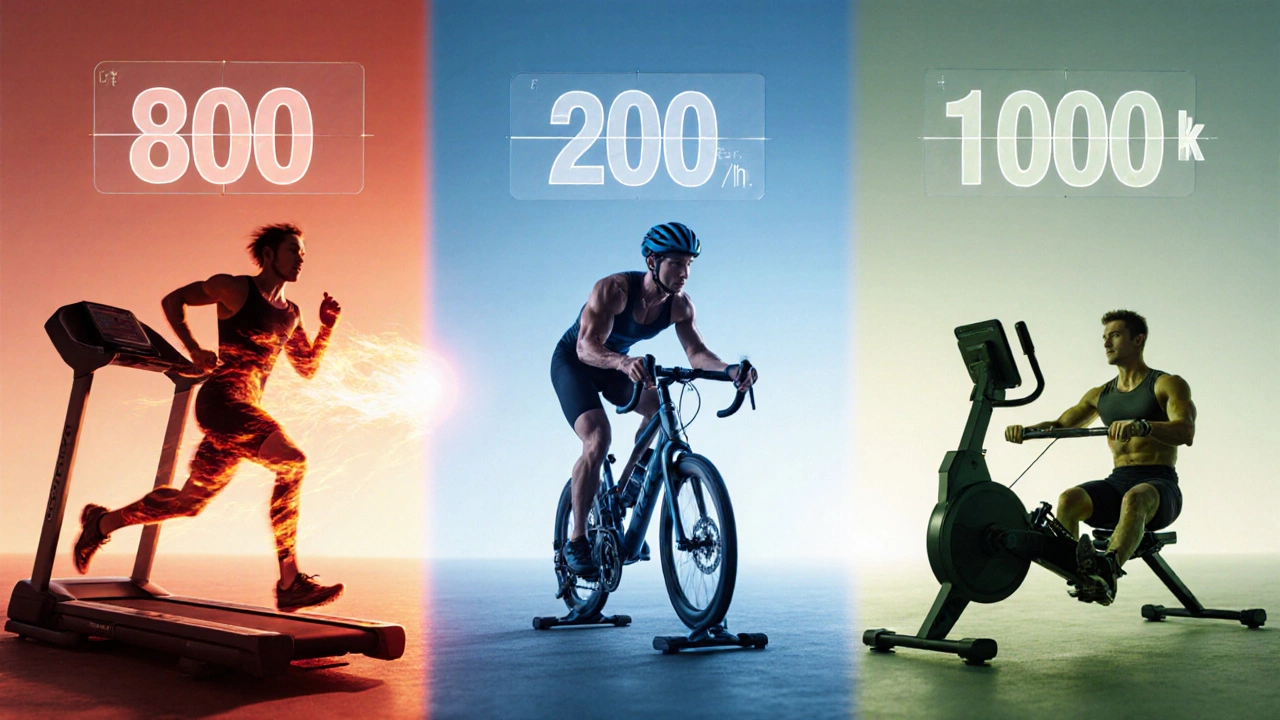Best Cardio Workouts for Maximum Weight Loss

Cardio Burn Calculator
Estimated Calorie Burn
Based on your inputs, you can expect to burn approximately calories during your workout.
This estimate includes both immediate calorie burn and afterburn (EPOC) effects.
Ever wondered which cardio move actually melts the most pounds? The answer isn’t a single exercise but a mix of intensity, duration, and how your body reacts after the session ends. Below you’ll find the science, the numbers, and a practical plan that lets you pick the cardio that fits your life and burns the most fat.
Key Takeaways
- High‑Intensity Interval Training (HIIT) tops the list for calories burned per minute and afterburn effect.
- Steady‑state cardio still matters for endurance, joint health, and calorie accumulation over longer periods.
- Running, rowing, and cycling each have unique calorie‑burn profiles; choose based on equipment, preference, and injury history.
- Mixing intervals with moderate sessions gives the best balance of fat loss and recovery.
- A sample weekly schedule can be built in under 30 minutes per day.
How Cardio Burns Calories
When you move, your muscles need energy. That energy comes from stored glycogen and fat. The faster and harder you work, the more calories you spend per minute. Two concepts drive weight‑loss results:
- Immediate calorie burn - the calories you burn while exercising.
- Afterburn (EPOC) - excess post‑exercise oxygen consumption, which keeps your metabolism elevated for 30‑90 minutes after a hard session.
Understanding both helps you compare cardio options beyond just the "minutes on the bike" metric.
Major Cardio Types and Their Calorie Profiles
Below is a snapshot of the most common cardio forms, their average calorie burn for a 155‑lb person, and how much afterburn they typically generate.
| Workout | Avg. Calories / Hour | Intensity Level | Afterburn (EPOC) % | Equipment Needed |
|---|---|---|---|---|
| HIIT short bursts of max effort followed by rest | 800‑1000 | Very High | 15‑30 | Bodyweight or basic gear |
| Steady‑State Cardio continuous moderate pace for 30‑60 minutes | 500‑650 | Moderate | 5‑10 | Any cardio machine or outdoors |
| Running jogging or sprinting on treadmill or outdoors | 600‑900 (5mph‑10mph) | Variable | 10‑20 | Running shoes, optional treadmill |
| Cycling stationary or road bike effort | 550‑850 (moderate‑vigorous) | Variable | 8‑15 | Bike |
| Rowing full‑body rowing machine workout | 600‑850 | Variable | 12‑18 | Rowing machine |
| Swimming continuous laps in a pool | 500‑700 | Variable | 6‑12 | Pool access |
| Elliptical Trainer low‑impact, full‑body motion | 550‑800 | Moderate‑High | 7‑13 | Elliptical machine |
| Treadmill walking, jogging, or running on a belt | 500‑900 (incline varies) | Variable | 10‑20 | Treadmill |

Why best cardio for fat loss Is Usually HIIT
HIIT’s calorie burn per minute outruns most steady‑state options because you’re forcing your heart and muscles to work near their max. The real kicker is the afterburn: your body continues to use oxygen, burn fuel, and repair muscles long after the timer stops. Studies from the Journal of Sports Science (2023) show a 20‑minute HIIT session can expend as many calories as a 45‑minute jog, plus an extra 10‑15% are burned during recovery.
But HIIT isn’t a free pass to exhaustion. You need to keep intervals short (20‑40 seconds) and allow adequate rest (1‑2 minutes). This way you stay in the high‑intensity zone without sacrificing form, which reduces injury risk.
When Steady‑State Still Wins
If you’re new to exercise, have joint issues, or simply enjoy longer sessions, steady‑state cardio shines. Running at a comfortable pace for 45‑60 minutes builds aerobic capacity, improves circulation, and burns a steady stream of calories. For many people, the cumulative burn over a longer period adds up, especially when paired with a balanced diet.
Another advantage is mental. Some find the rhythm of a long bike ride or swim meditative, making it easier to stick with the habit.
Choosing the Right Cardio for Your Body and Lifestyle
Here’s a quick decision guide:
- Limited time? Go HIIT - 15‑20min max effort.
- Joint pain or mobility issues? Choose elliptical, rowing, or swimming - low impact, full‑body work.
- Prefer outdoor scenery? Run, cycle, or hike - adds variety and fresh air.
- Access to a gym? Mix treadmill, rowing machine, and stationary bike for variety.
Remember, consistency beats perfection. Pick the mode you’ll actually do three times a week.
Sample Weekly Cardio Mix (30‑45min per session)
- Monday - HIIT (20min): 30sec sprint / 90sec walk, repeat 8times.
- Tuesday - Steady‑state cycling (40min) at moderate resistance.
- Wednesday - Active rest (light yoga or walk).
- Thursday - Rowing intervals (25min): 1‑min hard / 1‑min easy, 12 rounds.
- Friday - HIIT bodyweight circuit (20min): burpees, jump squats, mountain climbers.
- Saturday - Long run or swim (45min) at comfortable pace.
- Sunday - Rest or low‑intensity stroll.
Adjust the order to match your schedule, but keep the pattern of 2‑3 high‑intensity days and 2‑3 moderate days each week.
Common Pitfalls and How to Avoid Them
- Overtraining - doing HIIT every day can spike cortisol and stall weight loss. Schedule at least 48hours between high‑intensity sessions.
- Skipping warm‑up - a 5‑minute light jog or dynamic stretch reduces injury risk and improves performance.
- Ignoring nutrition - cardio burns calories, but a surplus of even 200kcal can stall progress. Track intake for the first month.
- Focusing only on the scale - muscle gain, water retention, and fat loss can mask progress. Use measurements or how clothes fit as additional markers.
Putting It All Together: Your Path to Faster Weight Loss
Start by testing two cardio styles you like. Record heart rate, perceived effort, and post‑exercise fatigue for a week. Choose the one that feels challenging yet doable, then add a second mode for variety. Track calories burned (most fitness watches give a decent estimate) and combine with a modest calorie deficit of ~300‑500kcal per day.
Within 4‑6weeks you should notice tighter waistlines, improved stamina, and a higher resting metabolic rate - the hallmarks of effective cardio‑driven weight loss.
Frequently Asked Questions
Does HIIT burn more fat than steady‑state cardio?
Yes. HIIT provides a higher calorie burn per minute and a larger afterburn effect, meaning you keep burning calories for up to an hour after the workout. For most people, a 15‑minute HIIT session equals the calorie cost of a 30‑45‑minute jog.
How many HIIT sessions per week are safe?
Aim for 2‑3 sessions with at least 48hours between them. This gives your nervous system and muscles time to recover, which is crucial for preventing injury and keeping performance high.
Can I lose weight with only low‑impact cardio?
Absolutely. Swimming, elliptical, or rowing can create a sizable calorie deficit when done consistently. Pair them with a modest diet plan and you’ll still see steady weight loss, though the pace may be slower than HIIT.
What’s the best way to track cardio calories?
Use a heart‑rate monitor or a fitness watch that estimates calories based on age, weight, and heart rate. For the most accurate numbers, combine device data with a manual log of duration and perceived effort.
Should I eat before cardio?
If you’re doing high‑intensity work, a small carb snack (15‑30g) 30‑45minutes before can boost performance. For low‑ to moderate‑intensity sessions, many people feel better exercising on an empty stomach, which may increase fat oxidation, but stay hydrated.